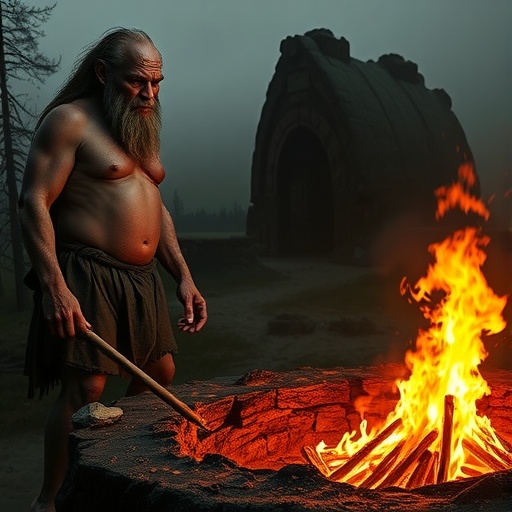Imagine a prehistoric Europe where dense forests stretched across vast terrains, populated by colossal herds of megafauna including elephants, bison, and aurochs. Small groups of human ancestors, wielding rudimentary tools and controlling fire, coexisted within these landscapes tens of thousands of years ago. Recent research spearheaded by an international team, including scientists from Aarhus University, revolutionizes our understanding of how these early humans influenced their environment—not as mere bystanders, but as active engineers shaping the continent’s vegetation long before farming emerged.
Employing state-of-the-art computational simulation models, the researchers integrated complex ecological variables such as climate fluctuations, large herbivore populations, natural wildfires, and human activities to unravel the drivers behind vegetation patterns during two pivotal warm periods: the Last Interglacial (approximately 125,000 to 116,000 years ago) and the Early Holocene (12,000 to 8,000 years ago). By juxtaposing simulation outputs with extensive pollen records spanning these epochs, the team deciphered the relative contributions of natural and anthropogenic forces in sculpting Europe’s ancient landscapes.
The analysis reveals that neither climate variability nor the presence of megafauna alone adequately explains the floral compositions observed in fossilized pollen data. Instead, incorporating human influences—specifically Neanderthal fire use and hunting pressure in the Last Interglacial, and Mesolithic hunter-gatherer activity in the Early Holocene—produces simulations that align much more closely with paleoecological evidence. This finding profoundly challenges the long-held assumption that pre-agricultural Europe existed as a pristine wilderness untouched by human hands.
Neanderthals, who roamed Europe during the Last Interglacial, were not passive inhabitants but engaged in fire management and preyed upon gigantic herbivores. Some prey, such as the straight-tusked elephant weighing up to 13 tonnes, illustrate the Neanderthals’ capacity to significantly disturb animal populations. Their hunting led to reduced grazing pressure, indirectly fostering denser vegetation as fewer herbivores consumed young plants and saplings. However, due to relatively low human numbers, this ecological impact remained moderate and did not eradicate the megafauna or their ecological roles.
In contrast, the Early Holocene witnessed Mesolithic hunter-gatherers of Homo sapiens exerting a far more marked influence on plant distribution and landscape openness. Simulation results estimate that humans shaped nearly half—around 47%—of plant community distributions during this period. Their fire regimes, combined with effective hunting strategies, diminished the abundance and diversity of large grazers, promoting shifts in vegetation patterns at a continental scale. This dual mechanism demonstrates early Homo sapiens as pivotal engineers, proactively transforming ecosystems millennia before the advent of agriculture.
Underpinning this breakthrough is an innovative interdisciplinary approach combining ecology, paleoecology, archaeology, and advanced artificial intelligence algorithms. Specialist knowledge of pollen, or palynology, furnished critical empirical benchmarks, while computational models allowed researchers to iterate and optimize scenarios efficiently. This use of AI-driven optimization algorithms in ecological simulation marks a cutting-edge methodological leap, enabling robust inference about prehistoric human-environment interactions that were previously speculative.
The implications of these findings extend beyond ecological history. They demand reconsideration of the “natural” baseline landscapes often cited as reference points in conservation biology and rewilding efforts across Europe. Recognizing that early humans co-created ecosystems foregrounds a more dynamic view of human agency within nature and encourages nuanced strategies that account for long-standing anthropogenic influences instead of aspiring toward a hypothetical untouched wilderness.
The study also highlights profound differences across epochs. While Neanderthals shaped environments to a measurable extent, Mesolithic hunter-gatherers’ impacts were both quantitatively and qualitatively greater, reflecting demographic expansions and cultural advancements in fire use and hunting technologies. Moreover, the disappearance of megafauna in the Holocene aligns with intensified human pressure, underscoring Homo sapiens’ unprecedented role in restructuring ecosystems globally.
While this research illuminates prehistoric human ecological impacts in Europe, knowledge gaps linger, especially regarding early hominin effects across different continents and time periods. The authors emphasize potential future studies employing similar computer simulations to examine North and South America and Australia, regions unpopulated by archaic hominins before Homo sapiens. Such comparisons may reveal unique trajectories of landscape transformation influenced solely by anatomically modern humans.
Local-scale studies remain indispensable complements to continental models. High-resolution archaeological and paleoecological investigations can elucidate the nuanced spatial and temporal variability of human-environment interactions, refining the broader patterns revealed by simulations. This synergy between macro-modeling and detailed empirical research promises richer insights into humanity’s deep ecological history.
In sum, this pioneering work redefines prehistoric hunter-gatherers from passive consumers of resources to active, large-scale ecosystem engineers. Both Neanderthals and Mesolithic Homo sapiens significantly shaped Europe’s vegetation thousands of years before the Neolithic revolution introduced farming. By integrating cutting-edge computational modeling with multidisciplinary data, the study unveils a more intricate narrative of human ecological legacy—one that challenges stereotypes and enriches our understanding of nature’s co-evolution with humankind.
Subject of Research:
Ecological impact of prehistoric hunter-gatherers on European vegetation during the Last Interglacial and Early Holocene periods.
Article Title:
On the ecological impact of prehistoric hunter-gatherers in Europe: Early Holocene (Mesolithic) and Last Interglacial (Neanderthal) foragers compared
News Publication Date:
22-Oct-2025
Web References:
https://journals.plos.org/plosone/article?id=10.1371/journal.pone.0328218
References:
Published article in PLOS One, 22 October 2025.
Keywords:
Prehistoric human impact, Neanderthals, Mesolithic hunter-gatherers, European vegetation, ecological simulation, pollen analysis, megafauna, fire ecology, landscape transformation, computational modeling, interdisciplinary research




